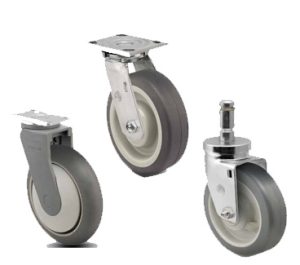
You can’t ignore load height when shopping for casters. Whether you’re planning to install them on the bottom of a cart, toolbox, chair or any other object, you’ll need to consider the casters’ load height.
Casters, of course, are undriven wheels with a mountable frame. When installed on the bottom of an object, you’ll be able to roll the object. While there are many different types of casters, however, they all have a load height.
Overview of Load Height
Load height refers to the distance from the top mounting surface of a caster to the bottom of the wheel. It’s known as “load height” because it represents the height of the load with which the caster is used. Installing casters on the bottom of an object will make it taller. Load height represents this increase in height.
How to Calculate Load Height
You can calculate load height by measuring the distance from the top mounting surface of a caster to the bottom of the caster’s wheel. The greater the distance between these two areas, the higher the caster’s load height will be. Alternatively, when shopping for casters, you may discover the load height listed under the casters’ specifications.
Clearance
Why does load height matter exactly? It will affect the clearance of the object or objects with which you use the casters. If you’re planning to use a set of casters on an already tall object, you may want to opt for a low load height. A low load height will minimize the additional height the casters add to the object or objects. A high load height, on the other hand, will result in a significantly taller object or objects.
Center of Gravity
Another reason low height is important involves the center of gravity. All objects have a center of gravity. When installing casters on the bottom of an object, you’ll change its center of gravity. The higher the casters’ load height, the higher the object’s center of gravity will be. If you’re worried about the object tipping over, you may want to choose casters with a low load height.
Ergonomics
Low height plays an important role in caster ergonomics. When pushing or pulling objects with manual material handling equipment, such as carts or dollies, the load height directly affects the posture required by the operator. Choosing casters with an appropriate load heigth will improve the casters’ ergonomics, which may in turn lower the risk of musculoskeletal disorders (MSDs).
